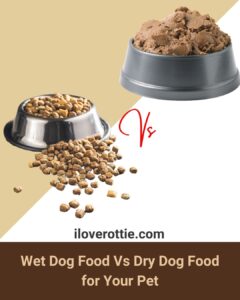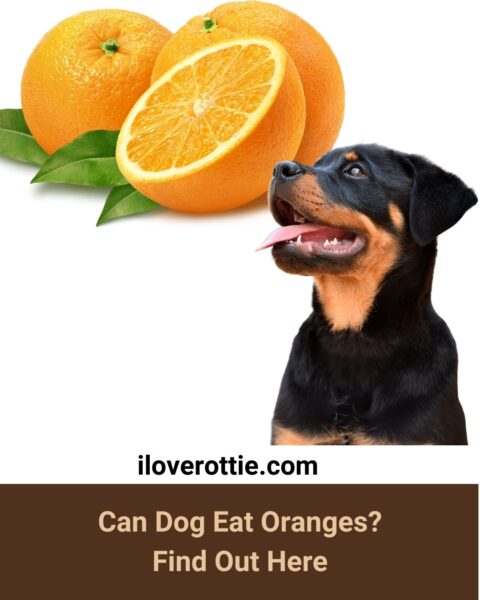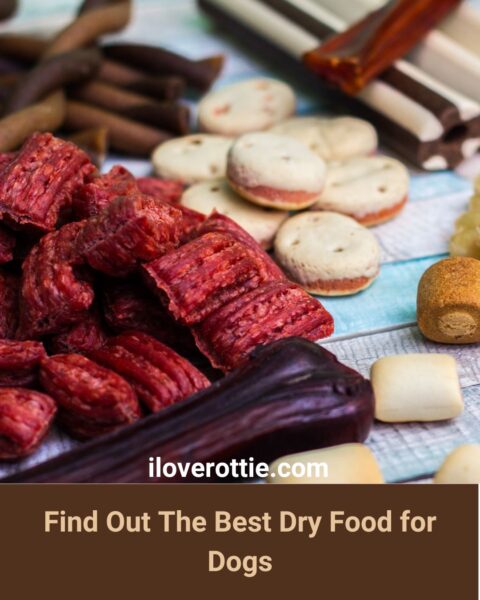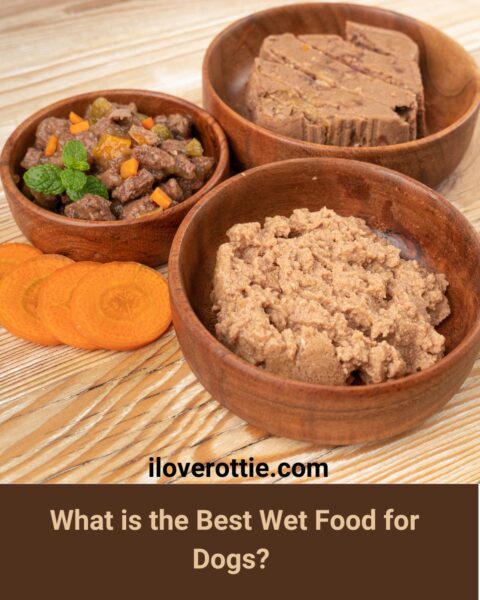When it comes to choosing the right food for our beloved furry friends, many dog owners find themselves pondering over the age-old question: wet or dry dog food? Hours of research and countless discussions are often dedicated to unraveling the mystery of which option is superior.
However, the truth is that both wet and dry dog food can provide a complete and balanced diet, as long as they are appropriately formulated. In this article, we will explore the key considerations for selecting dog food and shed light on the benefits and drawbacks of both wet and dry options.
Click here to read up on the best wet food and best dry food for dogs.
Which is Better: Wet or Dry Dog Food?
Many dog owners spend hours researching the question of whether wet or dry dog food is the better option for their pet. The reality is that both wet and dry food are able to provide everything your dog needs to stay happy and healthy, so long as the food is appropriately formulated.
When selecting a dog food, keep an eye out for the word “complete”, as this identifies the food as providing a balanced diet even when fed alone. A dog food marketed as “complete” is suitable to feed exclusively, even with nothing else added, although of course, you can still supplement a complete dog food with the odd treat!
When it comes right down to it, there’s no one-size-fits-all answer to the question “which is better: wet or dry dog food?”. This is because each type of dog food offers benefits, but equally come with drawbacks.
So, it’s important to consider these benefits and drawbacks in light of your own pet’s individual needs. Your dog’s preference is also important, with some pets showing a clear inclination towards wanting to eat either canned food or dry dog food.
Whichever option you end up selecting, be sure to pick a dog food that is formulated with high quality ingredients, and be aware that different brands will variety greatly in terms of their standards. Stick to a brand you trust, ideally one that provides products formulated with veterinary input.
The ultimate takeaway is that your dog can likely maintain optimal health with either wet or dry food – or a mix of both – so long as it’s done right.
 Wet Vs Dry Dog Food – Health Conditions
Wet Vs Dry Dog Food – Health Conditions
The presence of certain health conditions might make wet or dry dog food a more suitable choice for your pet. Likewise, the wish to minimise the risk of certain health conditions – such as dental problems – may be a factor when it comes to making this decision.
Dental Health
Kibble wins outright when it comes to dental hygiene. It’s believed that the mechanical action of crunching dry kibble may be helpful in disrupting the formation of plaque, thus slowing tartar buildup and maintaining clean teeth [1].
Appetite Issues and Additional Energy Requirements
A bowl of dry food will usually provide significantly more calories than the same bowl of wet food. This is because wet food has a much higher water content, which leaves less room for dry matter (fats, proteins and carbohydrates).
Because of this, dry food may be best for pets with reduced appetite or anorexia. Dry dog food might also be preferable for those with additional energy requirements such as young, growing animals, and pregnant or nursing mothers. If you do choose to feed wet in these circumstances, consider feeding a puppy wet food, as puppy food has a higher energy content.
Kidney Disease
Wet dog food is preferable to kibble if your canine family member is affected by kidney disease. This is due to the higher water content of wet food, which will help to maintain your pet in a well hydrated state.
Weight Management
Wet dog food is usually also the better choice for weight management and weight loss. Because of its higher water content, wet food is bulkier, so may help your dog feel fuller compared to eating an equal volume of dry food. Wet dog food typically also provides significantly fewer calories per unit of weight.
Advantages and Disadvantages of Wet Dog Food
Advantages of Wet Dog Food
- Helps maintain a well hydrated state.
- Seems to taste better – dogs prefer wet!
- Gentler on the mouth. Feeding wet or canned food is non-negotiable if your pup has recently had a dental that involved any extractions.
Disadvantages of Wet Dog Food
- Spoils quickly; dry food stays fresh for longer periods, particularly once opened, and doesn’t need to be refrigerated – always a benefit for the low maintenance pet parent!
- Not recommended for use in puzzle toys from a hygiene point of view.
- You will need to be a bit more rigorous with cleaning your dog’s bowl if feeding wet, to avoid bacterial growth.
Is it Ok to Feed Dogs Wet Food Only?
It’s absolutely fine to feed your dog a diet of 100% wet or canned dog food, as long as you select a wet food that is “complete”. Many pet parents prefer the approach of mixing wet and dry foods, as this provides the best of both worlds.
 Why Do Dogs Prefer Wet Food Over Dry Food?
Why Do Dogs Prefer Wet Food Over Dry Food?
Wet food is often the better choice for fussy dogs who struggle to maintain their ideal weight. Many dogs – especially picky eaters – seem to prefer wet dog food over dry diets. There are several reasons why this might be the case. For one thing, most dogs seem to prefer protein rich foods, and wet dog food tends to contain fewer carbohydrates compared to dry.
Wet food is often particularly favoured by senior dogs, who are more likely to suffer from dental problems. Wet dog food may be more comfortable to chew if your dog’s teeth are currently in need of some attention, or your pet has difficulty chewing. Older dogs are also more likely to be missing teeth as a consequence of advanced periodontal disease or previous dental extractions, so may struggle to chew kibble.
Is Wet Food Easier for Dogs to Digest?
Dry dog food commonly contains a higher level of carbohydrates than wet or canned dog food, since starches are required to provide structure and binding to the kibble. Contrary to popular belief, our canine companions don’t have an identical digestive system or identical enzyme expression when compared to their ancestors. Our pups are significantly better able to digest starch and metabolise glucose compared to wolves [2].
That said, the curious pet parents may be interested to know that there is evidence to suggest that fresh or wet dog food diets may still be more digestible and provide more metabolisable energy than dry kibble diets. In one study, dogs fed wet food had fewer bowel movements, and their bowel movements were less voluminous and contained less energy upon analysis, showing that more energy had effectively been absorbed by the dog [3].
It is also worth being aware however that some research also exists to suggest that for small breed older dogs specifically, dry dog food may be better digested than wet dog food [4]. More research is needed in this area of veterinary medicine, to clarify this point.
 Is Wet or Dry Food Better for Dogs with Sensitive Stomachs?
Is Wet or Dry Food Better for Dogs with Sensitive Stomachs?
When looking at dry dog food compared to wet, a common question is which option is better for dogs with a sensitive stomach. Since wet dog food may be easier for some dogs to digest, it’s reasonable to expect that wet foods may be the better option for dogs with digestive issues. This may be the case to some extent, but really the key concern is not whether the food is wet or dry, but rather, what proteins the dog food contains.
This is because most commonly, dogs with food sensitivities or allergies are intolerant of, or allergic to, specific proteins in their food; most commonly beef, chicken, wheat, soy and dairy [5].
So really, whether you feed a wet dog food or hard kibble to your delicate doggo doesn’t matter too much in this case. Choosing a food that doesn’t contain allergens (ideally an anallergenic or hydrolyzed diet) is what’s most important here.
Other Dog Food Options
Fresh/home cooked
Fresh and home cooked diets can be a great alternative to canned dog food, but can be unbalanced if not carefully formulated. For this reason, these diets should not be undertaken without input from a vet or veterinary nutritionist.
Semi Moist
Some dog food brands offer this newer alternative to wet, dry and canned food options. Like dry foods, this type of diet in a bag and appears “kibble-like”, yet it has a noticeably higher moisture content.
Unfortunately, many of these foods contain chemical flavor enhancers, artificial colors and preservatives, meaning they are not the best way to meet your pet’s nutritional needs. They also tend to contain higher levels of sugar, which promote dental disease.
Raw Diets
Commercial or home-prepared raw diets are commonly fed due to unsupported claims of dental health benefits. At the time of writing, there are no clear health benefits to feeding a raw diet, yet there are well-documented risks.
The vast majority of vets and veterinary nutritionists agree that raw food diets are dangerous for your pup’s health, as well as being hazardous for human health. They also contribute to a very real public health crisis, the rise of antimicrobial resistant bacterial populations. For this reason, raw dog food is absolutely not recommended.
Wet Dog Food and Dry Dog Food are Both Great Options
In conclusion, the debate between wet and dry dog food ultimately boils down to individual circumstances and preferences. When making a decision, it’s crucial to consider your dog’s specific needs, such as their health condition, age, and taste preferences.
Additionally, consulting with your veterinarian can provide valuable guidance tailored to your pet’s unique requirements. Remember, what matters most is ensuring your furry friend receives the necessary nutrients and enjoys their meals, whether they prefer the convenience of dry kibble or the moisture of canned food.
Wonder whether dogs can have tomatoes? Click here to find out.
Can dogs eat almonds? Read here.
Reference List:
[1]Gawor et al. Influence of Diet on Oral Health in Cats and Dogs. The Journal of Nutrition. (2006)
[2] Alvarenga, I.C., Aldrich, C.G. and Shi, Y-C. Factors Affecting Digestibility of Starches and Their Implications on Adult Dog Health. Animal Feed Science and Technology. (2021)
[3] Tanprasertsuk, J., Perry, L.M., Tate, D.E., Honaker, R.W. and Shmalberg, J. Apparent Total Tract Nutrient Digestibility and Metabolizable Energy Estimation in Commercial Fresh and Extruded Dry Kibble Dog Foods. Translational Animal Science. (2021)
[4] Kim, K.H et al. Age-related Digestibility of Nutrients Depending on the Moisture Content in Aged Dogs. Journal of Animal Science and Technology. (2021)
[5] Mueller, R.S., Olivry, T. and Prelaud, P. Critically Appraised Topic on Adverse Food Reactions of Companion Animals (2): Common Food Allergen Sources in Dogs and Cats. BMC Veterinary Research. (2016)

 Is Wet or Dry Food Better for Dogs with Sensitive Stomachs?
Is Wet or Dry Food Better for Dogs with Sensitive Stomachs?










